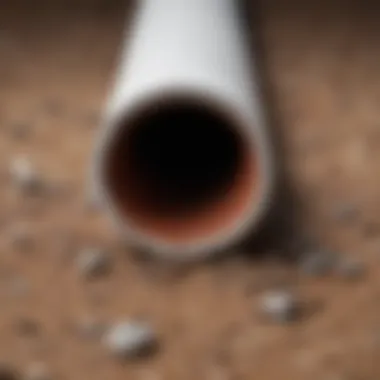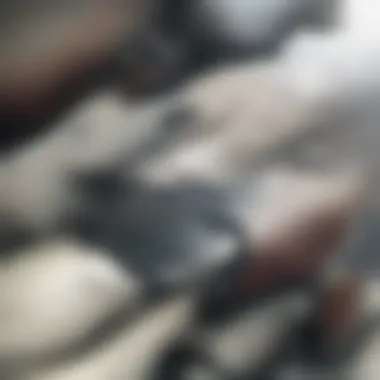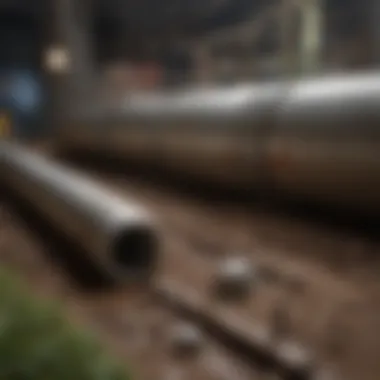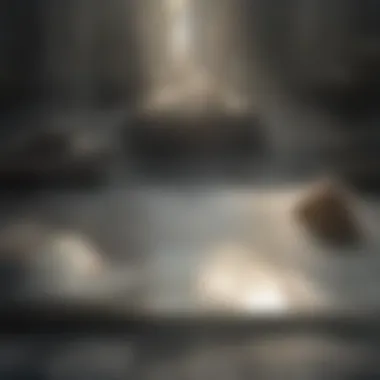Understanding PVC Pipe Blockage: Causes and Solutions


Intro
PVC (Polyvinyl Chloride) pipes are widely utilized in plumbing systems due to their resilience and cost-effectiveness. However, blockages remain a critical concern that can disrupt household functionality and compromise the efficiency of plumbing infrastructure. Understanding the roots of PVC pipe blockages is imperative for homeowners and professionals alike as it allows for proactive measures, effective problem resolution, and ultimately, enhances the integrity of living spaces.
In this article, we will explore various causes of pipe blockage, the visible effects on systems, and actionable solutions. This will provide readers with a comprehensive perspective, ensuring informed decisions in maintaining their plumbing systems.
Intro to PVC Pipe Blockage
PVC pipes play a critical role in modern plumbing systems, especially in residential spaces. Understanding the blockages that can occur within these pipes is essential for maintaining efficient and reliable plumbing. Blockages not only disrupt water flow but can also lead to costly repairs and health risks. This article aims to provide a comprehensive overview of PVC pipe blockages, addressing causes, effects, and solutions.
Defining PVC Pipes and Their Uses
Polyvinyl chloride, or PVC, is a synthetic plastic polymer widely used in plumbing. Its durability, low cost, and resistance to corrosion make it a popular choice for piping systems. PVC pipes are commonly used for water supply lines, drainage systems, and other plumbing applications.
The primary characteristic of PVC pipes is their lightweight nature. This feature facilitates easy transport and installation. Additionally, they are less prone to rust and corrosion compared to traditional metal pipes, which extends their lifespan and reduces maintenance costs. PVC is also safe for drinking water applications, confirming its versatility in various plumbing scenarios.
Importance of Plumbing Systems in Residential Spaces
Plumbing systems are foundational aspects of residential properties. Effective plumbing ensures that water delivery and waste removal are accomplished seamlessly. These systems contribute significantly to the comfort and functionality of a home, impacting daily activities such as cooking, cleaning, and sanitation.
When plumbing systems function optimally, they enhance the overall quality of life. However, interruptions caused by blockages can lead to significant inconveniences. Homeowners often face unexpected repairs and disruptions when blockages occur, underscoring the necessity of understanding PVC pipe blockage. Regular maintenance and awareness can prevent these issues, thus safeguarding the integrity of residential plumbing.
"Effective plumbing is not just about water flow; it’s about sustaining a healthy and well-functioning home environment."
Common Causes of PVC Pipe Blockage
Understanding the common causes of PVC pipe blockage is crucial for maintaining efficient plumbing systems. Preventing blockages can save homeowners both time and money. This section will outline significant factors that lead to blockages, providing insights into how these issues arise and their implications. Knowing these causes helps in timely intervention, preventing further complications in the plumbing infrastructure.
Accumulation of Debris
One of the most prevalent causes of PVC pipe blockage is the accumulation of debris. Over time, organic materials, grease, hair, and other waste can gather, creating a solid mass that obstructs water flow. This typically occurs in household plumbing where sinks, showers, and drains see regular use. Debris can particularly build up in slow-moving sections of pipes. It is essential for homeowners to realize that regular cleaning can significantly mitigate this issue. Simple actions such as using drain covers can minimize debris entering the system.
Tree Root Intrusion
Tree root intrusion is another common cause of blockages in PVC pipes, especially in older homes with extensive landscaping. Roots naturally seek water, and if there are cracks in the PVC pipes, they can infiltrate. This intrusion can cause severe blockages and even break pipes if not addressed. Homeowners should inspect their yards and be mindful of the types of trees planted near underground plumbing. In some cases, installing root barriers can prevent roots from damaging plumbing infrastructure.
Pipe Misalignment and Damage
Misalignment and physical damage to pipes add more complexity to PVC pipe blockages. Misaligned pipes can lead to changes in water flow, creating areas where debris can settle and accumulate. Damage, whether due to external pressure, soil movement, or poor installation, can exacerbate this problem. Homeowners must periodically check for visible signs of misalignment or damage. Regular inspections can help identify issues early on, avoiding more significant problems in the future.
Chemical Build-Up
Chemicals used for cleaning and maintenance can also contribute to blockages in PVC pipes. Certain substances may react with the pipe material, leading to corrosion or chemical build-up that hinders water flow. Common household cleaners, grease removers, and other chemical agents should be used with caution. It is advisable to consult with plumbing professionals when selecting cleaning agents. Using more environmentally friendly alternatives can also help in managing chemical residues within plumbing systems.
Effects of PVC Pipe Blockage
Understanding the effects of PVC pipe blockage is vital for maintaining the overall function of plumbing systems. This section outlines the significant impacts that blockage has on both operation and safety. Blockages can lead to reduced water flow, more serious structural damage, and potentially harmful health risks. Being aware of these effects allows homeowners and professionals to act proactively, avoiding more complicated and costly repairs.
Impact on Water Flow


One of the primary consequences of PVC pipe blockage is the disruption of normal water flow. When debris accumulates in pipes, water struggles to move efficiently. As a result, faucets may produce low water pressure, or depending on severity, water may not flow at all. This condition can lead to frustration among users as daily activities like showering or cooking become cumbersome.
Moreover, irregular water flow can exacerbate blockages, leading to further clogs. Such cycles create a demanding maintenance routine. Understanding this impact prompts the importance of preventive measures to maintain optimal water circulation.
Potential Damage to Plumbing Infrastructure
The structural integrity of plumbing infrastructure is at stake when blockages occur. Continuous pressure from trapped liquids and solids can lead to pipe ruptures. Once damage occurs, costly repairs or replacements become necessary. Even PVC pipes, known for durability, can suffer under persistent blockage scenarios.
It’s also important to note that infrastructural damage may extend beyond the immediate pipes. Issues like leaks can occur at joints or other connection points, which may cause water damage to surrounding areas. Such repairs can be labor-intensive and expensive. Homeowners should recognize that a timely response to blockages is crucial in protecting their plumbing systems.
Health Risks Associated with Blockages
Blockages not only pose a risk to the plumbing system but can also introduce health hazards. Stagnant water caused by clogs can become a breeding ground for bacteria and mold. These microorganisms can later contaminate the water supply, leading to health problems for those who consume or come into contact with it. Symptoms may range from mild gastrointestinal issues to severe respiratory problems.
In addition, some blockages can cause backflow, which pushes contaminants back into household plumbing systems. This situation is particularly concerning and necessitates immediate attention. Homeowners should be aware of the potential health implications that can arise from neglected blockages.
Recognizing the broader effects of PVC pipe blockage can inform better practices for regular maintenance and prompt interventions when issues arise.
Detection Methods for PVC Pipe Blockage
Detecting PVC pipe blockages is a crucial aspect of maintaining a functional plumbing system. Identifying blockages early can save homeowners significant time and money. This section discusses effective methods for detecting such issues to ensure that plumbing systems remain efficient and safe. The techniques covered include visual inspection, plumbing cameras, and water flow analysis, each offering distinct benefits and considerations.
Visual Inspection Techniques
Visual inspection is often the first step in detecting a blockage. Homeowners can look for signs such as slow drainage, unusual smells, or discolored water. Inspecting visible parts of the plumbing system, like sink drains and toilet outlets, helps recognize potential problems. One can observe for leaks, corrosion, or damages in visible pipes.
However, this method has its limitations. Blockages often occur deeper in plumbing systems, making them invisible during preliminary checks. Visual inspection may not reveal all underlying issues but can provide initial clues that warrant further investigation.
Using Plumbing Cameras
Utilizing plumbing cameras is an advanced method for detecting blockages in PVC pipes. This technology involves inserting a small camera into the plumbing system to obtain a real-time view of the inner condition of the pipes. This method allows for an in-depth analysis of any issues, including accumulation of debris or structural damage.
Benefits of using plumbing cameras include:
- Precision: High-resolution imaging provides clear visuals of blockages.
- Assessment: It allows for a thorough assessment of hard-to-reach areas within the plumbing system.
- Non-invasive: A plumbing camera inspection does not require excavation or disruption to landscaping.
Despite these advantages, it requires professional assistance and comes with a cost. Nonetheless, the insights gained often justify this investment, especially for serious plumbing concerns.
Water Flow Analysis
Water flow analysis is another important technique to detect potential blockages. This method involves measuring water pressure and flow rates in the plumbing system. A sudden drop in flow can indicate the presence of a blockage. Regular monitoring can also help establish a baseline, making it easier to identify anomalies.
Conducting a water flow analysis can involve:
- Pressure gauges: Measuring water pressure at various points in the system.
- Flow meters: Assessing the rate of water flow through the pipes.
While this method is effective, it may require specialized equipment or professional assistance for accurate results. Homeowners who understand the flow patterns can take proactive measures before minor issues escalate into significant blockages.
In summary, each detection method has its strengths and limitations. Combining techniques can lead to a more comprehensive understanding of the plumbing system’s health, aiding in early detection and effective resolution of PVC pipe blockages.
Prevention Strategies for PVC Pipe Blockage


Effective prevention strategies can significantly extend the life of your PVC pipes and maintain the functionality of plumbing systems. Proactive measures not only reduce the frequency and severity of blockages but also minimize costly repairs and disruptions. Here are a few essential strategies to consider:
Regular Maintenance Practices
Regular maintenance is a cornerstone for preventing PVC pipe blockage. Homeowners should inspect their plumbing systems regularly to identify potential problems before they escalate. Simple cleanliness measures include:
- Routine flushing of toilets and drains: This helps in clearing out any minor debris that may accumulate.
- Periodic drain cleaning: Using safe, non-corrosive substances to clean drains periodically can prevent chemical build-up.
- Checking for leaks: Identifying leaks early prevents water damage and supports overall plumbing integrity.
The benefit of regular maintenance lies in its ability to catch issues before they become expensive problems. Not only does this save on costs, but it also ensures a seamless plumbing experience for homeowners.
Appropriate Disposal of Waste Materials
Another crucial element in preventing blockages is the proper disposal of waste materials. Many homeowners contribute to pipe issues by disposing of items that do not belong in plumbing systems. Common items include:
- Cooking grease and oils: These substances can harden in pipes, leading to severe blockages.
- Paper products: Items like wipes, even those labeled as flushable, can cause significant plumbing issues.
- Chemical cleaners: These may seem like a quick fix but can lead to long-term damage to pipes.
Educating household members on appropriate disposal techniques minimizes the risk of blockages. An accessible waste disposal system, coupled with consistent reminders about what not to discard, plays a pivotal role in maintaining clear pipes.
Root Barrier Installation
For properties near trees, root barrier installation emerges as a vital preventive strategy. Tree roots can penetrate pipes, leading to blockages and damage. Common strategies include:
- Physical barriers: Installing root barriers can redirect roots away from pipes.
- Choosing the right plants: Planting trees with non-invasive roots near plumbing can minimize risk.
- Regular landscaping checks: Monitoring the health of landscaping ensures roots do not surge toward plumbing.
Proper installation and maintenance of these barriers can prevent root interference, ensuring that pipes remain intact and functional over time.
Resolution Techniques for PVC Pipe Blockage
Addressing PVC pipe blockage requires a methodical approach. Different techniques can effectively resolve issues based on the nature and severity of the blockage. Each method has its own set of advantages and considerations that are vital for homeowners and plumbing professionals alike. Understanding these resolution techniques can aid in maintaining plumbing systems, ensuring unobstructed flow, and avoiding potential damage to the plumbing infrastructure.
Using Plumbing Snakes
Plumbing snakes, or augers, are tools designed to clear blockages in pipes. They are long, flexible tubes that can access deeper areas of a plumbing system. The main advantage of using a plumbing snake is its ability to reach blockages that may not be easily accessible otherwise. It functions by dislodging debris and allowing it to wash away or be pulled out.
To use a plumbing snake effectively:
- Insert the snake into the drain until you reach the blockage.
- Rotate the handle to break up debris.
- Withdraw the snake carefully to remove any dislodged materials.
Considerations include the type of blockage, as harder obstructions may require multiple attempts. Misuse of the tool can also cause damage to pipes. Hence, having some experience or following guidelines is essential.
Hydro Jetting Procedures
Hydro jetting is a powerful technique that involves using high-pressure water streams to clear blockages. This method is effective for severe or stubborn blockages and can remove built-up grease, debris, and even tree roots. Hydro jetting is preferred for its ability to clean pipes more thoroughly than other methods.
The procedure generally includes:
- Inspection: Using cameras to ascertain the blockage type and pipe condition.
- Positioning the hose: Inserting a high-pressure nozzle into the pipe.
- Initiating high-pressure water flow: Blast water under pressure to break apart debris and clear the path.
While effective, hydro jetting requires professional handling to avoid damage to older or brittle pipes. It is also more costly compared to simpler methods, making cost considerations important.
Chemical Remedies: Pros and Cons


Chemical remedies encompass various products designed to dissolve or dislodge clogs within pipes. They come in liquid or granulated forms and can be effective for tough blockages such as grease buildup. However, there are advantages and disadvantages to their use.
Pros:
- Ease of Use: Many chemical products can be applied by homeowners without special tools.
- Quick Results: Depending on the product, some chemicals can show results within a few hours.
Cons:
- Pipe Damage: Repeated use or improper application can corrode pipes, especially in older plumbing systems.
- Environmental Impact: Some chemicals can pose risks to ecosystems if disposed of improperly.
In summary, while chemicals can offer an immediate solution, the long-term implications should be considered. Their use should be minimized, especially in favor of mechanical solutions like plumbing snakes or hydro jetting, which are generally safer for the pipe infrastructure.
Regular maintenance and early detection are key to preventing PVC pipe blockages, which can extend the life of plumbing systems and reduce costs.
When to Call a Professional
Determining the right time to engage a plumbing professional can significantly impact the resolution of PVC pipe blockages. It is essential to understand that not all blockages warrant professional intervention. However, knowing when to make that call can prevent further damage and costly repairs in the future.
Identifying Severe Blockages
Several factors can indicate that a blockage has reached a critical state. First, if multiple fixtures in your home are affected simultaneously, this can suggest a major blockage in the main sewer line. Common signs include unexpectedly low water pressure across different taps or slow drainage in multiple areas. It can signal that the blockage is extensive.
Persistent odors emanating from drains is another warning sign. Such unpleasant smells often indicate trapped debris or stagnation, which may not be easily resolvable with household tools. If you are experiencing sewage backup or visible sewage, such as pooling water around your property, these could also indicate a severe issue requiring immediate professional assessment.
"Recognizing the severity of a blockage early can save homeowners from more extensive damage and repair costs."
Cost Considerations
Before deciding to call a professional, cost is often a crucial concern for homeowners. Understanding the potential expenses involved can guide effective decision-making.
The initial consultation fee for hiring a plumber ranges significantly based on location and the complexity of the issue. Routine evaluations may cost less than resolving severe blockages, which often require additional resources. Projected expenses might soar when advanced detection methods like hydro-jetting or specialized camera inspections are needed.
Moreover, consider the costs associated with ineffective DIY attempts. Poor handling of plumbing issues typically leads to escalating problems. These could necessitate more expensive interventions later, making timely professional involvement a financially prudent choice.
In summary, recognizing severe blockages and understanding cost implications are essential in deciding when to engage a professional. Taking proactive steps may not only resolve the problem but also preserve the overall integrity of your plumbing system.
Ending
The conclusion in this article is essentiial for consolidating the understanding of PVC pipe blockage. It serves as a vital summary of the key insights covered, highlighting both the challenges and solutions faced in maintaining efficient plumbing systems. PVC pipe blockage can lead to severe consequences, affecting not only water flow but also the overall health of plumbing infrastructures.
A thorough conclusion allows readers to reflect on the importance of regular maintenance and the impact of prevention strategies. By embracing proactive measures, one can mitigate the risks associated with blockages. This section also empowers homeowners and professionals to recognize the indications of severe blockages and to understand when it's appropriate to seek professional assistance.
Moreover, the conclusion presents an opportunity to reiterate the interconnectedness of a well-functioning plumbing system with the aesthetic quality of residential spaces. Plumbing is often unnoticed until a problem occurs, making it critical to appreciate the maintenance of such systems during the design and operational phases of a home.
An understanding of PVC pipe maintenance as outlined in this article ultimately enhances the overall success of property management and operation, benefitting all stakeholders involved.
Summary of Key Points
In review, this article has conveyed several significant aspects regarding PVC pipe blockages:
- Common Causes: Accumulation of debris, tree root intrusion, and chemical buildup are prevalent contributors to blockages.
- Effects: These blockages adversely affect water flow and can lead to fundamental damage to plumbing systems and health risks.
- Detection Methods: Effective techniques range from visual inspections to the use of advanced plumbing cameras for thorough analysis.
- Prevention Strategies: Regular maintenance and appropriate waste disposal prove effective in avoiding blockages.
- Resolution Techniques: Employing plumbing snakes or hydro jetting can resolve minor issues, while severe cases may necessitate professional intervention.
Final Thoughts on PVC Pipe Maintenance
Maintaining PVC pipes is not merely about addressing current issues; it is about establishing a forward-thinking approach. Homeowners and professionals alike should adopt a mindset of anticipation. Good maintenance plans involve regular inspections and established protocols for waste management. When one becomes familiar with their plumbing system components, recognizing warnings becomes easier.
Furthermore, considering root barriers if tree intrusion is likely in your area can save significant time and costs in the future. Awareness of these preventive measures is beneficial, ensuring both comfort and safety in residential spaces. Ultimately, eyeing holistic well-being through proper plumbing maintenance reflects wise stewardship of both property and investments.







